Micro-Packaging Market Size
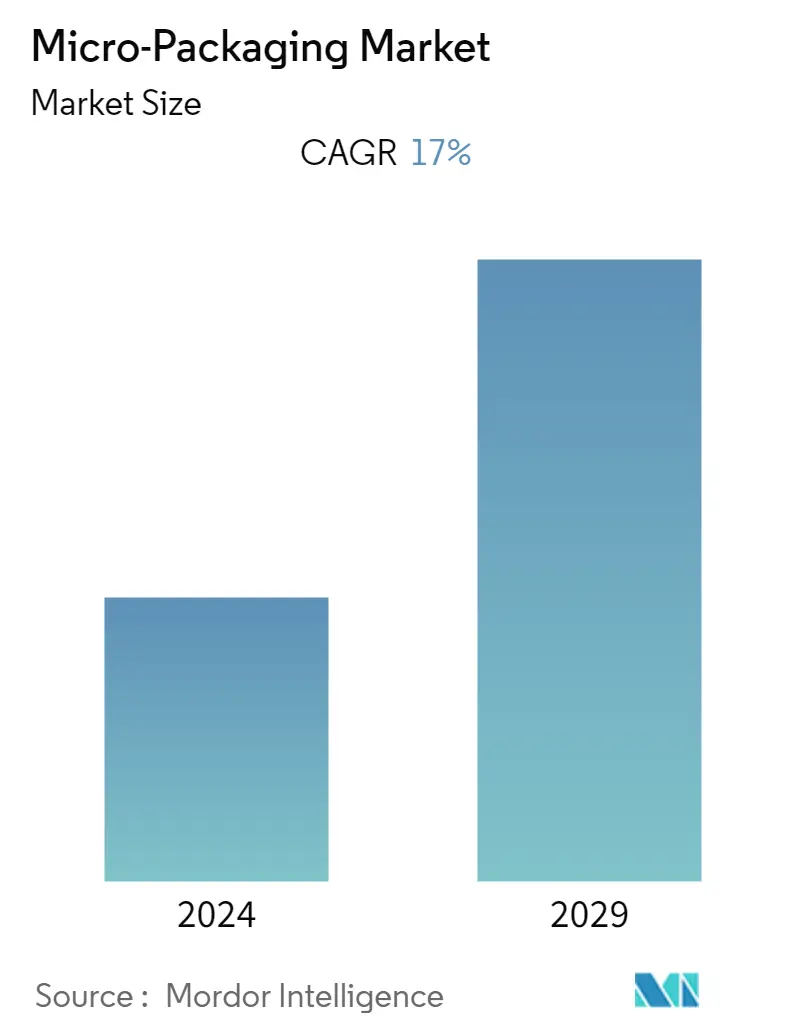
| Study Period | 2019 - 2029 |
| Base Year For Estimation | 2023 |
| CAGR | 17.00 % |
| Fastest Growing Market | Asia Pacific |
| Largest Market | North America |
| Market Concentration | Medium |
Major Players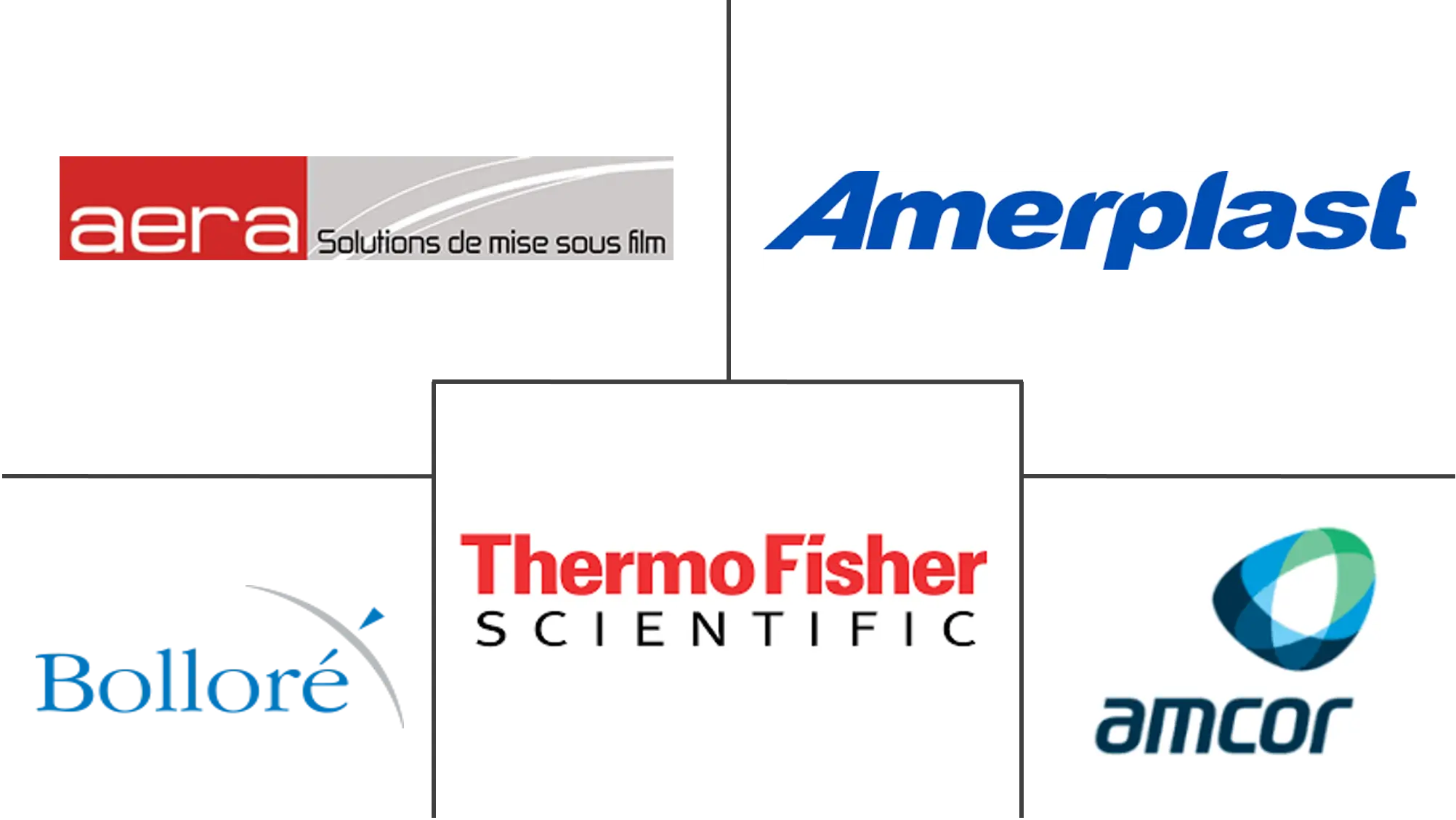
*Disclaimer: Major Players sorted in no particular order |
Micro-Packaging Market Analysis
The micro packaging market is expected to grow at a CAGR of 17% over the forecast period (2021-2026). With the current study of plastic packaging, manufacturers are exploring alternatives such as plant-based fibers. An example is micro fibrillated cellulose (MFC) where plant fiber breaks down to micro levels and is reconstituted as packaging material. The process can create materials that are stronger and lighter than those made of glass or carbon fibers, and MFC can be added to other packaging materials to strengthen them. With the implementation in the future, this packaging technique can provide a new trend in the market.
- Micro-perforated food packaging is specifically used for perishable food products, aiming to extend shelf life and improve the moisture retention of the products. According to the Food and Agriculture Organization of the United Nations, in the United States, the production quantity for vegetables in 2018 increases to 807349 tonnes from 709033 tonnes in 2017. With the increasing consumption the growth for micro packaging increases. Also, scientists are focusing to enhance the functional properties of films for active food packaging. For instance, in Aug 2019, scientists from the Department of Process Engineering, Stellenbosch University, South Africa aims to form Acetylated hemicellulose films that are suitable for fatty foods packaging using acetylated nano-cellulose reinforcement and polycaprolactone coating.
- Also in Dec 2019, from the Department of Food and Nutrition, BioNanocomposite Research Center, Korea, scientists experimented with a synthesis of Fe3O4/SiO2/PAMAM dendrimer/AgNP hybrid nanoparticles for the preparation of carrageenan-based functional nanocomposite film which exhibits high UV-barrier property and clear antibacterial activity against foodborne pathogenic bacteria.
- The origin of new drug delivery systems and the development of new biochemical compounds drive the market. The burden of chronic diseases is rapidly increasing worldwide and according to WHO, it has been calculated that, in 2001, chronic diseases contributed approximately 60% of the 56.5 million total reported deaths in the world and approximately 46% of the global burden of disease.
- The proportion of the burden of NCDs (Non-communicable disease) is expected to increase to 57% by 2020. Almost half of the total chronic disease deaths are attributable to cardiovascular diseases; obesity and diabetes. These diseases cater a demand for medicine providing micro packaging owing to its ability to enhance stability and shelf life to the drug and the delivery system.
- Leaching of nanoparticles restraints the market to grow. There is an impact on the stability and chemical activity of nanomaterials, as the size and shape of the initial nanoparticles may change dramatically. For antimicrobial activity, a small amount of silver slowly migrate from the inside of the packaging material to the surface and release the silver ions to attack microorganisms. Consequently, AgNPs are probably ingested via food that contacts the packaging surface.
Micro-Packaging Market Trends
This section covers the major market trends shaping the Micro-Packaging Market according to our research experts:
Food Packaging Accounted for High Market Growth
- In the food packaging sector, the prospective of nanotechnology is actively explored including active packaging. The transformation of active compounds from micro to nanoscale offers thereby a new opportunity. Silver nanoparticles are among the most explored nanoparticles, owing to their established antimicrobial potential against multiple commensal and pathogenic strains.
- In response to the vital changes in current consumer demand, the area of Active Packaging (AP) is becoming increasingly significant in food packaging. Principal AP systems include those that involve oxygen scavenging, moisture absorption and control, carbon dioxide and ethanol generation, and antimicrobial (AM) migrating and nonmigrating systems.
- Antimicrobial activity perforates at every corner of the package and its provides surface protection due to the gaseous characteristic of the agent. Some of the antimicrobials (bacteriocins, enzymes, organic acids, nano-sized metal oxides, etc) are handled as non-volatile basis agents in active antimicrobial food packaging and need to be directly contacted with the food.
- Moreover, Micro-perforation implies the puncturing of packaging films with holes ranging from a diameter of 30 mm to approx 200 mm. This packaging offers various superiority including extended shelf life and moisture retention to the food products.
- The industry witnessed a high demand for micro-perforated packaging materials in the form of films and laminates for the packaging of a wide variety of fruits & vegetables. This growth is backed by increased consumption of fruits such as bananas, mangoes and other citrus fruits and vegetables such as potatoes, onions, and tomatoes.
- The United States is witnessing a swift rise in its existing population, primarily due to work-related migrations into the country. This rising population directly impacted the food industry and affected the packaging industry and forms a major part of the workforce dependent on frozen foods and packaged food for appetite. This factor inhibits the demand for micro packaging.
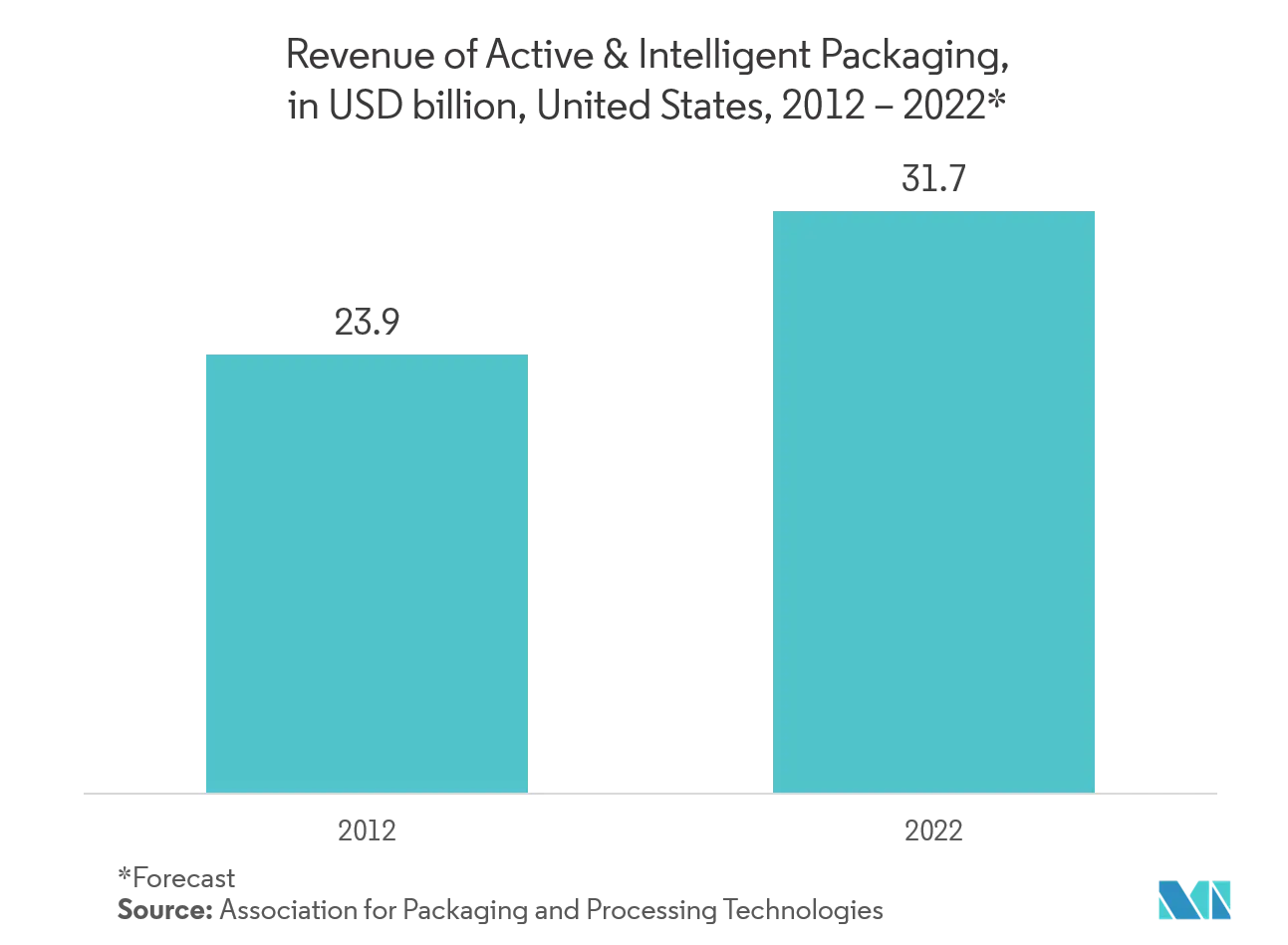
North America Witness High Market Share
- Rapidly expanding the retail sector incites manufacturers to adopt advanced packaging solutions. Leading food and beverage makers from around the world are constantly looking out for packaging materials that fit to their requirements. According to United States Department of Agriculture, in 2017, 64.1 pounds of chicken per person on a boneless, edible basis were available for Americans to eat and in 2018, 35.2 pounds per person of corn products (flour and meal, hominy and grits, and food starch) were available for consumption in the United States. Micro packaging helps to preserve the meat fresh during shipment and for food products it provides barrier properties against the external environment. This product demands increases every year which says that the demand for micro packaging increases in this segment.
- Moreover, the demand for medicine in pharma sector exhibits growth. For instance, according to IQVIA, the total spending on medicines in the United States increased to USD 482 billion in 2018 compared to 2017 which was USD 454.7 billion. With increasing demand, the growth of micro packaging increases, especially for vial and sachet packaging.
- Also, the players are increasingly focusing to innovate in the micro packaging sector. New developments such as Bayer Cropscience AG, the chemical and pharmaceutical company produced a transparent film called durethan which contains nanoparticles of clay that offer a combination of properties which include high strength and toughness, abrasion resistance, chemical resistance, and resistance to cracking. This new film will inhibit the growth in the United States.
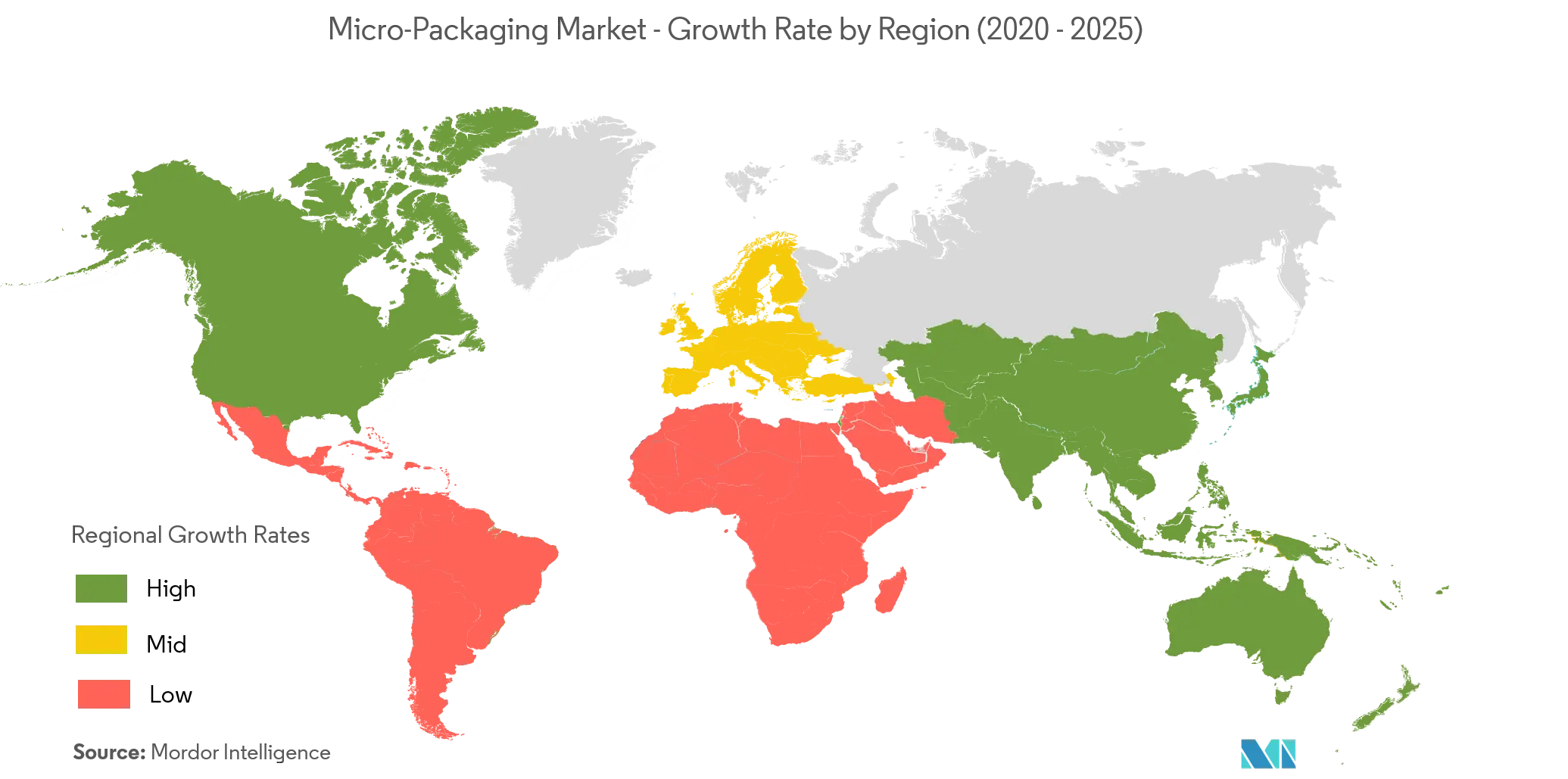
Micro-Packaging Industry Overview
Themicro packaging market is moving towards the fragmented market as the players are focusing to movetowards nano packaging due to its major advantage towards end-users packaging. Most of the players are still towardstraditional packaging, but various acquisitions, partnerships, and new innovative technology are shifting the market towards a more competitive market. Key players are Amcor Plc, Bollore, Amerplsdt Ltd, etc. Recent developments in the market are -
- Nov 2019 - The EU-financed NanoPack Project carried out a series of antimicrobial efficacy tests on its new film to demonstrate the capability to extend shelf life. During the tests, NanoPack’s film showed the ability to extend the shelf life of perishable goods such as bread, cherries, and yellow cheese, where the film is based on a combination of natural nanomaterials and essential oils to enhance food safety and reduce waste.
Micro-Packaging Market Leaders
-
Amcor Plc
-
Bollore Inc.
-
Amerplast Ltd.
-
Thermo Fisher Scientific
-
Aera SA
*Disclaimer: Major Players sorted in no particular order
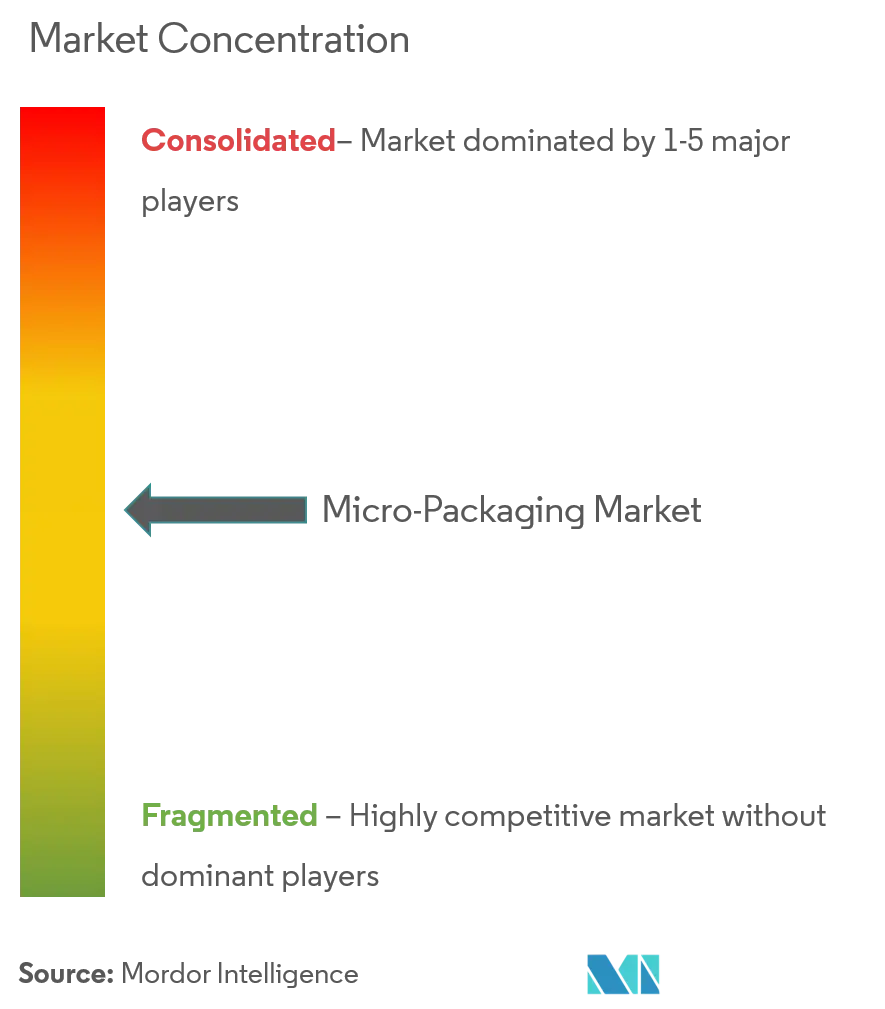
Micro-Packaging Market Report - Table of Contents
1. INTRODUCTION
- 1.1 Study Assumptions
- 1.2 Scope of the Study
2. RESEARCH METHODOLOGY
3. EXECUTIVE SUMMARY
4. MARKET DYNAMICS
- 4.1 Market Overview
-
4.2 Market Drivers
- 4.2.1 Demand For Micro-Perforated Food Packaging For Perishable Food Products
- 4.2.2 Advent of New Drug Delivery Systems And the Development of New Biochemical Compounds
-
4.3 Market Restraints
- 4.3.1 Leaching of Nanoparticles
- 4.4 Industry Value Chain Analysis
-
4.5 Industry Attractiveness - Porter's Five Force Analysis
- 4.5.1 Threat of New Entrants
- 4.5.2 Bargaining Power of Buyers/Consumers
- 4.5.3 Bargaining Power of Suppliers
- 4.5.4 Threat of Substitute Products
- 4.5.5 Intensity of Competitive Rivalry
5. MARKET SEGMENTATION
-
5.1 By Application Type
- 5.1.1 Vials
- 5.1.2 Boxes & Pouches
- 5.1.3 Trays
- 5.1.4 Other Application Types
-
5.2 By End-User
- 5.2.1 Food & Beverage
- 5.2.2 Pharmaceutical
- 5.2.3 Personal Care & Household
- 5.2.4 Other End-Users
-
5.3 Geography
- 5.3.1 North America
- 5.3.2 Europe
- 5.3.3 Asia-Pacific
- 5.3.4 Latin America
- 5.3.5 Middle-East and Africa
6. COMPETITIVE LANDSCAPE
-
6.1 Company Profiles
- 6.1.1 Amcor Plc
- 6.1.2 Bollore Inc.
- 6.1.3 Amerplast Ltd.
- 6.1.4 Thermo Fisher Scientific
- 6.1.5 Aera SA
- 6.1.6 A-ROO Company
- 6.1.7 Uflex Ltd
- 6.1.8 Chengde Technology Co., Ltd
- 6.1.9 TCL Packaging
- 6.1.10 Ultraperf Technologies Inc.
- *List Not Exhaustive
7. INVESTMENT ANALYSIS
8. MARKET OPPORTUNITIES AND FUTURE TRENDS
** Subject To AvailablityMicro-Packaging Industry Segmentation
Micro-packaging makes use of nanomaterials for prospective advantages such as enhanced antimicrobial effects, bio-availability, targeted deliverance of bioactive composites, thus increasing the demand for the micro packaging market in the end-user such as food, pharma, cosmetics, etc.
| By Application Type | Vials |
| Boxes & Pouches | |
| Trays | |
| Other Application Types | |
| By End-User | Food & Beverage |
| Pharmaceutical | |
| Personal Care & Household | |
| Other End-Users | |
| Geography | North America |
| Europe | |
| Asia-Pacific | |
| Latin America | |
| Middle-East and Africa |
Micro-Packaging Market Research FAQs
What is the current Micro-Packaging Market size?
The Micro-Packaging Market is projected to register a CAGR of 17% during the forecast period (2024-2029)
Who are the key players in Micro-Packaging Market?
Amcor Plc, Bollore Inc., Amerplast Ltd., Thermo Fisher Scientific and Aera SA are the major companies operating in the Micro-Packaging Market.
Which is the fastest growing region in Micro-Packaging Market?
Asia Pacific is estimated to grow at the highest CAGR over the forecast period (2024-2029).
Which region has the biggest share in Micro-Packaging Market?
In 2024, the North America accounts for the largest market share in Micro-Packaging Market.
What years does this Micro-Packaging Market cover?
The report covers the Micro-Packaging Market historical market size for years: 2019, 2020, 2021, 2022 and 2023. The report also forecasts the Micro-Packaging Market size for years: 2024, 2025, 2026, 2027, 2028 and 2029.
Micro-Packaging Industry Report
Statistics for the 2024 Micro-Packaging market share, size and revenue growth rate, created by Mordor Intelligence™ Industry Reports. Micro-Packaging analysis includes a market forecast outlook to 2029 and historical overview. Get a sample of this industry analysis as a free report PDF download.



